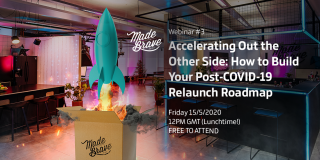In response to the economic changes caused by COVID-19, a lot of brands have gone right into survival mode. Some are hibernating, while others are pivoting at the speed of light. We’ve previously spoken about safeguarding your brand through these tough times, but as lockdown tentatively lifts around the world, all of us have the same question—uuhh, what’s next?
If this pandemic has taught us anything, it’s these two things:
1) No one really knows what’s going to happen next (including us!) and
2) It always helps to be prepared
Why brands should prepare for their relaunch sooner, rather than later
For businesses who have had to close their doors, or furlough their teams, post-COVID spending will be a lifeline for their livelihoods. A relaunch strategy will help them to make noise and capture the attention of their audience when they need it most.
Get ready for your customers
At any point, lockdown could be lifted, scientists could find a solution (fingers crossed) and the economy could kick into high-gear. You want to be ready for when that happens, right? By preparing your relaunch strategy now, you don’t have to wait around to make the most of an opportunity.
Don’t be the last to leave the ground
In a living room not-so-far away, your competition could be pulling together their relaunch strategy. Without realising, you’re in a space race to be the first one there when your customers need you.
There’s a ‘new normal’ ahead
According to a study by YouGov, only 9% of people in the UK want things to go back to the way things were before lockdown.
Why? In the same study, respondents said that since lockdown started, they noticed cleaner air, ate better food and felt a stronger sense of community. Maybe ‘normal’ wasn’t so great after all?
But, what does this ‘new normal’ mean for consumer behaviour?
During lockdown, people have been shopping online even more than they did before the pandemic hit—at least, that’s the case for 53% of those surveyed in a recent study. What’s more, 77% went on to say that they’ll likely continue to purchase online more, even once lockdown is over.
Most importantly, customers are expecting brands to be ethical in order to earn their support. A study by Kantar showed that 47% of consumers expect brands to help hospitals (either through donations or direct support), 39% said that brands should make themselves available to assist regional governments where needed and almost a third want companies to help them or provide advice on things like health, fitness and wellbeing.
For businesses, this shift in perspective will mean that the strategy you had pre-pandemic probably won’t be relevant to what your audience now values and expects. Now is the time to use this insight to re-strategise for the months ahead.
Some industries will take longer to recover
For some businesses, things aren’t going to be as simple as launching a new marketing campaign. Relaunching could mean a whole new product or service altogether. Let’s take the tourism industry, for example.
Across the UK, hotels are set to reopen from July 4th at the very earliest and the Health Secretary said that jetting off this summer looks highly unlikely. But even then, will people feel confident enough to get on a plane or stay in a hotel the minute bans are lifted? It’s likely that the tourism industry will feel the effects long after lockdown has ended. So, what are our tourism and hospitality friends to do?
In this post, our Creative Technologist, Calum talks about how brands can create experiences through virtual reality—allowing tourists to explore from the safety of their own home.

Credit: Unreal Engine – The Martian Experience
“It’s safe to say VR tourism cannot and will not replace traditional forms of tourism. However, in these times of mass isolation, it is important to explore new and creative alternatives to allow people to keep seeing and experiencing the world in all its beauty. Once traditional tourism has regained its footing, VR tourism could transition into a supporting role, allowing brands to tell stories about things that are difficult to experience.”
Hang on, I thought you said no one knows what’s going to happen next? So, what’s the point in planning for something if it’s going to change?
This is a really great question (we’re glad you asked).
It’s always important to leave room for flexibility in a strategy, especially now when society has completely changed as we know it.
When we’re faced with these situations, we should work on the things we can control:
- Persona research
- Competitor and sector analysis
- Brand sentiment
- Channel plans
- Creative executions
- Scenario planning
When we take the time to prepare what can be prepared, it means we have a strong foundation to be flexible when we need to be. From there, you can get into your scenario planning (similar to what you might do for cash flow scenario planning for your business) For example:
- What’s the most likely scenario?
- What’s the least likely?
- What’s the best case versus worst case, and
- How do you plan to adapt?
There’s much much more to it than this of course, which is why we ran a webinar with some of our strategy team to chat through our top tips for building a relaunch strategy:
How brands can plan their relaunch
Okay, you’re on board with the relaunch, but where do you start? Whether you’re switching your messaging or completely changing your business, you’ll need a strategy first.
Assess the now
As with any strategy, the first step is to take stock of who you are, where you are, what you have to offer, and most importantly—where the rest of the world is. You want to revisit your business objectives, key customer demographics, competitor analysis, brand positioning, best practice within your sector, and more.
Turn data into insights
To create a successful relaunch strategy, it takes both creativity and insight. Data and research are good to have, but when you take the time to translate them into insight, that’s when you can make informed decisions that turbocharge your strategy. It takes time, effort and know-how, but it’s more than worth it.
Choose your objectives
Now that you’ve analysed your place in the market, determined best practice, defined exactly what your business is offering the world, it’s time to define your KPIs and set your objectives. You want them to be precise and actionable, so everyone’s in the same rocketship. Here’s an example template:
We’re going to change x specific metric by exactly this much by this exact date.
Make way for great ideas
This is the fun part! Break out the sticky notes and whiteboard, and get your team all in one room (a digital one) to come up with as many ideas as you can. Make sure you have your research and insights to hand, then start by writing out all your strengths and weaknesses. Also have a think about the opportunities you can go after in your niche and any threats you need to watch out for (you know, things like pandemics, etc).
Remember, there’s no such thing as a bad idea at this stage. The goal is to come up with as many ideas as you can!
Lock down the logistics
Now pick one strategy (this’ll be the one that’s most likely to help you reach your objective) and figure out all the nuts and bolts of how you’re going to get it done. Who’s going to do what? When? How much are you going to spend and where? What are you going to say and what is it going to look like?
Are we done yet?
Nope! This is the strategy that never ends… because it doesn’t.
Before you implement anything, you need to get your reporting figured out, otherwise, how will you know if you’re moving in the right direction?
That’s a wrap!
It’s easy to dwell on what we’re missing, but to look on the bright side, this slower lifestyle has given us the time to reflect and really think about our brands. Sometimes, when we’re hurtling at top speed, we forget to take time out to look at our businesses and our communities as a whole. Now, there’s an opportunity to change that and relaunch as the brand you’ve always wanted to be.
Hey! Need a bit of support developing a relaunch strategy for your business?




